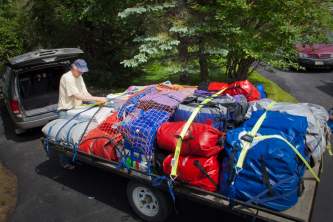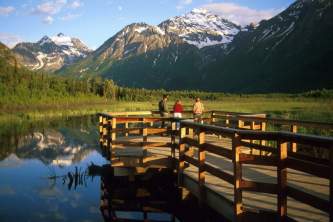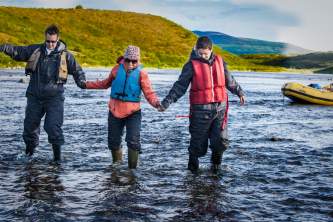What To Wear Hiking
The Basic Gear
Even on bluebird sunny day, we never set off without rain gear, extra clothing, gloves, a hat and/or a nylon neck buff. Temps can drop fast.
Here’s the complete rundown for how to pack for a day hike in Alaska:
Hiking Boots
- Don’t buy the classic, hard leather boots—too heavy for most day hikers, and hard to break in.
- Your best bet: lightweight boots with ankle support.
- Trail running shoes are fine if you’re used to them on uneven terrain.
- Alaska trails often feature wet or muddy stretches. Consider trail shoes with waterproof, breathable liners such as Gore-tex, or carry waterproof, breathable socks.
Dress in Layers
- Inside layer: Moisture-wicking fabrics against the skin, such as Capilene (also called polypropylene) or light wool.
- Sunny days. Drip-dry style long sleeve shirt and zip-off pants. They dry fast if you get sweaty, offer sun protection and can work as an outer layer over your poly-pro in light-but-chilly wind.
- Insulating layer: Expedition weight long underwear or light pile. For most summer hikes, you’ll only need a top. Great to put on at the summit or during lunch break.
- Outside layer: breathable yet waterproof fabric such as Gore-tex
- Rain forest? If hiking in areas like Prince William Sound or Southeast Alaska—with potential for unrelenting torrential downpours—consider carrying coated, waterproof rain gear as a back up.
Don't have this kind of gear? Rent it for your Alaska vacation from Alaska Outdoor Gear Outfitter & Rentals
Bear Protection
- Don’t bother with bells—your voice is just as much of a deterrent.
- Bear spray (pepper spray) has limited range, but is good to carry. Shoot downwind.
- Your best bet: Moderate noise. Hike in a group and keep the conversation going. If alone, sing! Almost all bears avoid the sound of human voices. Most bear attacks are on people who have surprised the animal while going solo. Groups with four or more are virtually bear proof.
- Check out our Alaska Bear Safety advice.
Moose protection
- Don’t approach too closely. Moose will likely be feeding and will almost always ignore you or move off. Give them space.
- If a moose acts aggressively or charges, back or run away. If necessary, duck behind a tree or other obstacle.
- Bear spray (pepper spray) has limited range, but is good to carry. Consider it a last resort.
- Check out our moose viewing advice.
Bug protection
- Carry bug repellent with Deet as the active ingredient. If the dope is 100 percent Deet, use sparingly.
- Carry an inexpensive bug net that will fit over a duckbill cap to cover head, neck and face. Airy and more pleasant than bug dope. You can usually find them camping sections of grocery superstores.
Cow parsnip protection
- This tall annual plant with large leaves grows profusely along many Alaska hiking trails. Avoid brushing your skin against it! The oils and juices of the plant can react with sunlight to cause burn-like blisters to erupt through the skin of susceptible people. These ulcers take a long time to heal.
- Hike with long sleeves and pants if hiking through cow parsnip. Lightweight cotton garden gloves or synthetic liners can protect hands.
- If exposure is unavoidable, stop frequently and rinse off any exposed skin in creeks, seeps and ponds. Try to do this before you spend time in direct sunlight. This actually works pretty well.
- Check out our cow parsnip page.
Water
If you’re heading out for a long hike, you’re probably going to need more water than you want to carry with you. The good news: there are streams everywhere. We Alaskans tend to take a bottle for water when hiking, and then just refill it in a stream or river. If you don’t want to, here are your options:
- SteriPen. UV lights kill bacteria, giardia, but don’t get rid of silt or grittiness from stream water. About $90.
- Filter Pump. Low-tech, but your best bet for removing bacteria and bulk. $40 and up for portable models.
- Purifying tablets. Iodine or Chloride tablets are cheap and lightweight, and a great back-up plan. Downsides: They’re slow (half an hour to four hours). Iodine makes the water taste funny, too. A few dollars.
Food
What’s a hike without a snack! It’s easy to tuck a carb-rich energy bar or trail bar or two into a pocket or a pack. Apples are super food that don’t get crushed. Consider keeping at least one snack untouched for emergencies or for one of those unexpectedly long days.
Sun Protection
Because of its lower angle on the horizon, the intensity of the sun in Alaska on a peak summer day is equivalent to a spring day in the Lower 48. But there are twice as many hours of daylight per day, so you definitely want to protect your skin.
- Bring a lightweight, brimmed hat for sun and rain, sunglasses, and sunscreen with sufficient UVA and UVB protection.
- Tighter weave hats offer more sun protection, but they don't breathe as well, so look for a vented wide brim hat.
- If you are hiking over or near snow, or along a body of water, your solar exposure will be much greater than you expect. Glacier travel is notorious for causing severe sunburns.
- Long-sleeve drip-dry shirts and zip-off pants also protect against sunburn without glopping on the lotion,
Change of Clothes
In case your clothes get wet while underway:
- Extra pair of socks.
- Extra long undershirt or upper body inside layer.
In case you return to the car soaked:
- Stash a change of dry clothes in the vehicle for the ride home. A great morale booster after an invigorating outing through the rain.
Advanced Gear
Thinking about a more extended hike? Or going off-trail or across tundra? Here are some tricks of the trade we’ve learned through experience.
About Those Zip-Off Leg Pants
- A huge convenience. If you get hot or cold, zip the lower pant legs on or off in a snap—no need to find a place to sit down and remove your whole pants.
- Pant legs also protect your calves when walking through brush. (See cow parsnip above!)
Hiking Poles
Don’t think of them as canes—here’s how any hiker will benefit from them:
- Elevation. When heading down hills, shifting weight to the poles will protect your knees.
- Uneven terrain. Using them on side hills—sloping terrain—can protect your ankles.
- Whacking. Poles are great for helping whack brush aside.
- Water crossings. Probe the depth of a stream before you plant your foot (or whole leg) into it.
- An extra pair of feet. They offer stability so you can look up and watch scenery, rather than your feet for every step.
- Shopping for Poles. Aluminum is cheaper and heavier, but carbon might not be as durable. Shock-absorbing tips are great if you’re carrying a heavy load, but overkill for most day hikers. Look for something that can collapse and attach well to your pack. Cost: anywhere from $70 to $150.
Gaiters (more for the hard-core, off-trail hiker)
- These nylon coverings fit over your lower pant leg and strap around the bottom of your shoe or boot.
- Extra protection from water, scrapes and debris that can get into your boots.
- Great if it rains—ground brush and twigs can get mushy and messy fast.
- About $25 a pair.
Pack a freezer bag with emergency gear
- For simple first aid problems, carry a roll of gauze, a roll of medical tape, a few bandage strips, a small tube of antibacterial ointment and a square of moleskin for heel blisters or hot spots.
- Include an inexpensive lightweight “space” blanket in case you get stuck overnight. Look for these items in camping sections of superstore groceries or outdoor stores.
- If traveling in country with downed wood that can be burned, carry fire-starter and matches.
- A pocketknife or multi-tool.
- For on-the-fly repairs: Dental floss to sew rips in clothing, a few wire ties or short span of bailing wire to tie up gear, a mini roll of duct tape to patch fabric.
Safety Plan
If you’re planning on an extended hike into the wilderness (say a day or more), think about communications before you leave.
- Don’t count on your cell phone—coverage tends to be spotty.
- Call a friend or family member before you set off. Tell them your route, amount of food, and when you expect to be back.
- Bring a hand-held GPS ($120-200) or compass and map in case you get lost. USGS maps in Anchorage.
- A lot of Alaskans use Spot, a satellite transmitter that updates your coordinates online and lets you send for rescue. About $250.




